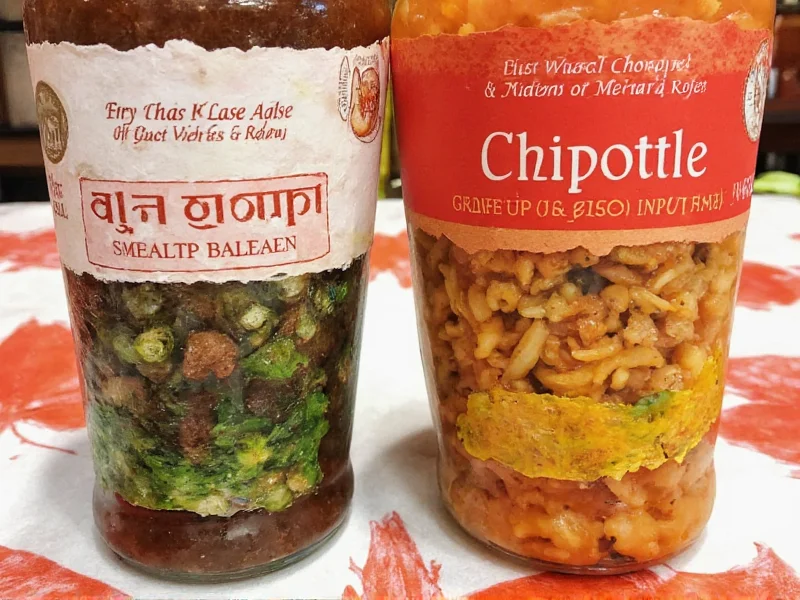Understanding the relationship between chipotle and jalapeño peppers transforms your cooking. These aren't separate pepper varieties but different forms of the same chili. The transformation from fresh jalapeño to chipotle creates dramatic flavor shifts that impact recipes significantly. This guide explores their differences in heat, flavor, culinary applications, and substitution strategies to help you make informed choices in the kitchen.
What Exactly Are Chipotle and Jalapeño Peppers?
Jalapeños are medium-sized green chili peppers harvested before fully ripening. They typically measure 2-3.5 inches long with smooth, glossy skin. Fresh jalapeños range from bright green to deep red when fully matured. These versatile peppers grow on Capsicum annuum plants and serve as the foundation for chipotles.
Chipotles aren't a distinct pepper variety—they're jalapeños that have undergone smoking and drying. The word "chipotle" comes from the Nahuatl language (chilpoctli), meaning "smoked chili." Traditional preparation involves smoke-drying ripe red jalapeños over wood fires for several days until they reach optimal moisture content. This process concentrates flavors while adding distinctive smokiness.
Flavor and Heat Comparison
The most significant difference between chipotle and jalapeño lies in their flavor profiles and heat characteristics. While both belong to the same species, their preparation creates distinct culinary experiences.
| Characteristic | Fresh Jalapeño | Chipotle Pepper |
|---|---|---|
| Scoville Heat Units | 2,500-8,000 SHU | 2,500-10,000 SHU |
| Flavor Profile | Grassy, bright, vegetal | Smoky, earthy, complex |
| Texture | Crisp, juicy | Leathery, chewy when rehydrated |
| Color | Green to red | Deep mahogany brown |
| Common Forms | Fresh, pickled, canned | Dried, in adobo sauce, powdered |
Despite similar Scoville ranges, chipotles often feel hotter than fresh jalapeños. This perception occurs because smoking concentrates capsaicinoids while removing water content. The smoky compounds also interact with heat receptors differently, creating a more intense sensation. However, individual pepper heat varies significantly based on growing conditions and seed placement.
Culinary Applications and Best Uses
Each pepper shines in specific culinary contexts due to their unique properties. Understanding these differences helps you choose the right ingredient for your dish.
Fresh Jalapeño Applications
- Salsas and fresh sauces - Their bright flavor enhances raw preparations
- Garnishes - Thin slices add color and heat to tacos, nachos, and soups
- Pickled preparations - Vinegar preserves their crisp texture
- Stuffed peppers - Hollowed jalapeños hold fillings well
- Ceviche and fresh salads - Adds subtle heat without overpowering
Chipotle Applications
- Moles and complex sauces - Smokiness adds depth to rich sauces
- Barbecue rubs and marinades - Complements grilled meats perfectly
- Bean dishes and stews - Infuses slow-cooked dishes with smoky notes
- Adobo sauce preparations - Chipotles in adobo provide ready-to-use flavor
- Smoky mayonnaise and dressings - Blended chipotles create signature sauces
Professional chefs often combine both peppers in recipes to create layered heat profiles. For example, fresh jalapeños might provide initial brightness while chipotles deliver lingering smokiness.
Substitution Strategies and Pairings
When you need to substitute chipotle for jalapeño or vice versa, consider these guidelines:
Replacing Fresh Jalapeño with Chipotle
Use 1-2 teaspoons of minced chipotle in adobo sauce per fresh jalapeño. Reduce other liquid ingredients slightly since chipotles in adobo add moisture. This substitution works well in cooked dishes but changes the flavor profile significantly.
Replacing Chipotle with Fresh Jalapeño
For every chipotle pepper, use one fresh jalapeño plus ¼ teaspoon smoked paprika. This approximates the smokiness but won't replicate the complex depth of true chipotles. Best for last-minute substitutions in cooked dishes.
Excellent flavor pairings include:
- Chipotle with chocolate, coffee, tomatoes, and citrus
- Fresh jalapeño with cilantro, lime, cucumber, and avocado
Storage and Preparation Tips
Proper handling preserves each pepper's unique qualities:
Fresh Jalapeño Storage
Store unwashed jalapeños in the refrigerator's crisper drawer for up to three weeks. For longer storage, slice and freeze them on a baking sheet before transferring to freezer bags. Never store at room temperature for extended periods.
Chipotle Storage
Dried chipotles keep for 6-12 months in airtight containers away from light. Chipotles in adobo sauce last one month refrigerated after opening. Freeze extra portions in ice cube trays for convenient future use.
Safety note: Always wear gloves when handling hot peppers and avoid touching your face. The capsaicin in both peppers can cause significant irritation to sensitive areas.
Nutritional Comparison
Both peppers offer impressive nutritional benefits with minimal calories. A single fresh jalapeño (14g) contains:
- 4 calories
- 9% of daily vitamin C
- 2% of daily vitamin A
- Trace amounts of B vitamins and potassium
One chipotle pepper (7g) provides:
- 6 calories
- 10% of daily vitamin C
- 15% of daily vitamin A
- Higher concentration of antioxidants due to drying process
The smoking process preserves most nutrients while concentrating certain compounds. Both peppers contain capsaicin, which research suggests may boost metabolism and reduce inflammation.











 浙公网安备
33010002000092号
浙公网安备
33010002000092号 浙B2-20120091-4
浙B2-20120091-4